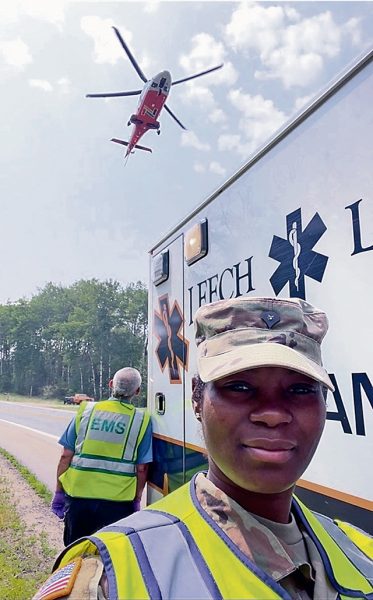
What started off as just another routine annual training event in Cass Lake, Minnesota, quickly developed into something much more for one Army Reserve Soldier, who found herself on the front lines of saving lives in a real-world situation that she won’t soon forget.
“It was surreal, it was unexpected,” said U.S. Army Reserve Spc. Ana Baker, a healthcare specialist, assigned to the 399th Field Hospital, 803rd Hospital Center, 804th Medical Brigade, 3rd Medical Command.
Baker was with her unit conducting a real-life medical assistance mission with the local civilian community providing no cost dental and medical care as part of an Innovative Readiness Training mission. The IRT was part of Operation Walking Shield, a joint medical assistance operation with the Minnesota Army National Guard.
“The Innovative Readiness Training missions provide patient care to select communities within the United States,” said Capt. Jamie Eastman, company commander, 451st Medical Detachment, 405th Field Hospital. “They are not only a benefit to those communities in need, but also to the Soldiers who are involved in providing care by helping them to maintain proficiency in their medical skills.”
During the community mission, the Emergency Medical Services provider for the region offered ride-along shifts in their ambulances to the Soldiers who are healthcare specialists. This provided an opportunity for the Soldiers to gain civilian EMS experience in addition to performing their primary IRT mission.
“EMS ride-alongs and hospital clinical experiences are vital for ensuring proficiency of U.S. Army medical providers,” said Eastman. “Many National Guard and Reserve Soldiers have a civilian medical career to maintain proficiency, but not all have the capability. Training opportunities like this ensure Soldiers are ready to respond when the mission calls.”
It was on one of these ride-alongs that Baker’s otherwise normal day would quickly change into one filled with excitement and drama. “I was scheduled to go with the ambulance crew for a few hours that afternoon,” said Baker, who had never been in an ambulance before. “I had heard Soldiers who had gone earlier in the day talking about how it was boring and that nothing had happened, so I took a book to read expecting to have plenty of down time. About 20 minutes into the shift the EMTs [emergency medical technicians] got a call and they just said, ‘we gotta go.’ I just thought, oh my goodness what is going on.”
Within moments the ambulance roared to life. With the siren blaring and emergency lights flashing, Baker and her EMS crew quickly made their way to the scene of a motor vehicle collision that had left a pregnant mother and her three young children in desperate need of emergency trauma care.
“I was riding in the back of the ambulance on the way there and I was nervous and excited and wondering what to expect,” said Baker. “I managed to put on my reflective vest and gloves and was just watching the EMTs and following their cues.
When we stopped, I could see a car that had ran off the road and had slammed into a tree backwards. There were several people already on the scene, and one of them, a bystander, handed me an 18-month-old boy, who had been involved in the collision. I took him into the back of the ambulance where I helped take his vital signs and assess him for injures.”
Soon another child from the accident would be brought into the ambulance as well. This time it was a two-year-old girl who had a large bump on her forehead.
Baker, who has a Bachelor of Arts degree in communications and psychology, spent the next hour on the scene with the children, doing her best to keep them calm and entertained while the responding emergency medical personnel called for a life-flight helicopter for the mother. Eventually the children would be treated and released to family members on the scene.
“It was an unfortunate situation, but it’s real life, and sometimes bad things happen in real life,” said Baker, a native of Jamaica. “I learned a lot from this experience. I saw how the EMTs approached the scene, how they interacted with the patients and young children and how they had a special approach to dealing with people in a situation like that to help them not only physically, but emotionally as well.”
Baker remembered how her Army medical training had helped prepare her for the stressful situation. “In our initial training we had a civilian instructor that would shout at us and really put a lot of added stress and pressure on us,” she said. “I see now why he did that. That added level of stress in my training helped me be calm during this real-life situation.”
Not only did those on the scene witness Baker’s calm demeanor and helpful medical expertise, but she also made an impression on her superiors.
“Spc. Baker is a passionate and motivated Soldier in our field hospital,” said Eastman. “Her drive and character were put to the challenge during this motor vehicle collision, where she was able to provide patient care in conjunction with the EMTs from the Leech Lake Ambulance. We are proud of her and the service she provided to the community.”
Looking to the future, Baker says she is hoping to get promoted soon, and is looking for an opportunity to deploy. “I want to deploy and see what that’s like,” she said. “While I’m serving in the Army Reserve I’ll continue to look forward to my annual training and just soak up as much information I can.”
She also plans to take additional classes to help her prepare for a future leadership role.
With her unit training complete and the incident now a memory, Baker reflects back on that incredible day. “I was in the right place at the right time,” she said. “It opened my eyes to a lot of things, and it’s an experience I’ll definitely remember for years to come.”


